Located on the southwestern coast of Europe, Portugal and its capital city, Lisbon, have been at the center of various waves of “globalization” linking Europe to Africa, the Americas and Asia.
Located on the southwestern coast of Europe, Portugal and its capital city, Lisbon, have been at the center of various waves of “globalization” linking Europe to Africa, the Americas and Asia.
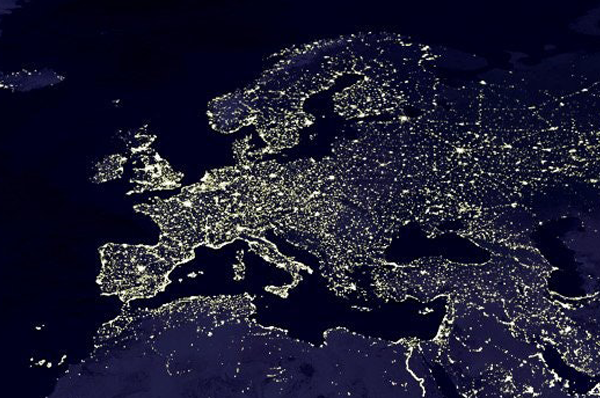
Portugal is located in Southeast Europe and bathed by the Atlantic Ocean. It is quick and easy to get from Portugal to all European capitals and to numerous cities around the World.

Besides its beauty, Portugal is also one of Europe’s safest countries, as evidenced by various crime statistics available on the Eurostat website. According to the 2019 Global Peace Index, Portugal is recognized as the third most peaceful and safest country in the world.
Lisbon, Portugal’s capital city, is in fact Europe’s safest capital, according to Eurostat (2010 report). Lisbon also ranks among the top 50 cities worldwide with respect to personal security (MERCER – Quality of living worldwide city rankings 2011).
No other Portuguese-speaking country enjoys this level of personal safety.
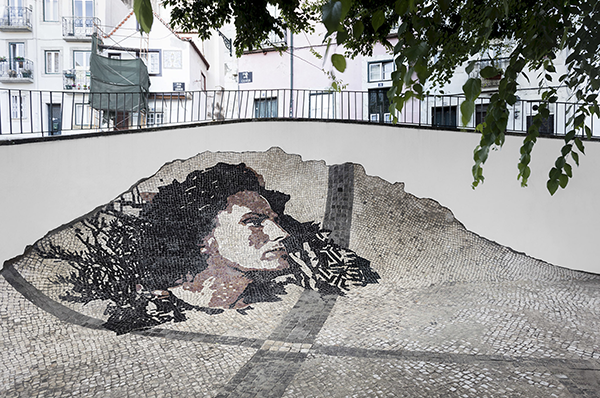
Pound for pound, it’s hard to imagine any other city of its size with a more flourishing arts and music scene.
Lisbon has long been one of the prettiest cities in Europe. Its pitched hills and valleys are like a Mediterranean-flavored San Francisco, and the streets seem to wear art on every surface. Beaux-Arts buildings are sheathed in Moorish tiles of bright blues and sunset reds; the sidewalks, too, are covered in mosaics.
Before it spread, the city’s street-art scene was concentrated in Bairro Alto, a hilltop bohemian neighborhood that was home to punks, metalheads, goths, gays, writers and artists in the 1980s and ’90s. The winding quarter still has the best bars, cafes, galleries, restaurants, boutiques, gay clubs and discos.
“Young Lisbon is indeed building like crazy: there is street art on decaying walls, experimental theater at the harbor, raves in old canneries. Everywhere, the anything-might-happen energy has spurred a desperation to create. Even the city has gotten into the act, setting up public walls as canvases and opening the Galeria De Arte Urbana to archive the graffiti.” In Crash and Boom, New York Times about Lisbon.
“Lisbon has no idea how cool it is. The city lives in the shadow of Europe’s superstar capitals” In Two Lively Districts in Lisbon, Every Night is a Block Party, New York Times

Portugal has a mild Mediterranean climate with over 200 days of sun per year. It’s the perfect place to spend lots of time outdoors biking, hiking, sunbathing, or spending the afternoon in an outdoor cafe with friends. Lisbon is the sunniest European capital. It has some of Europe’s mildest weather in the winter and pleasant summers.
The summer season is 6 months long, lasting from May to October, with average temperatures of 25°C (77°F) during the day and 16.2°C (61.2°F) at night.
December, January and February are the coldest and rainiest months, with an average daytime temperature during these 3 months of 15°C (60°F) and 9°C (48°F) at night.
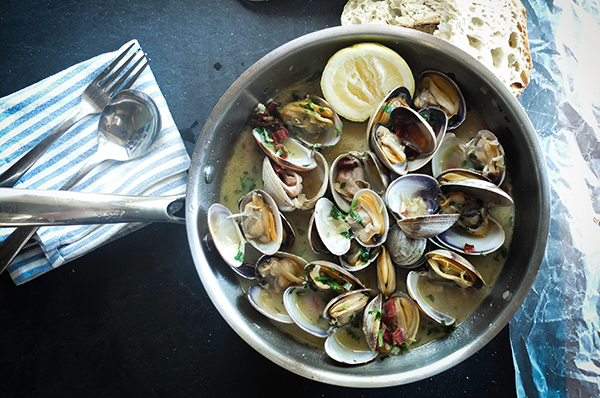
Portugal is a foodie’s paradise! Fresh fish – from grilled sardines to shellfish – is a must have in Lisbon. At many places you can pick from a wide selection of whatever was caught that day and the fish is grilled whole, head and all, for you to fillet yourself at your table. Bacalhau is another must. Salted, dried cod was the “faithful friend” that accompanied the Portuguese on their seagoing voyages. It remains the national dish that can be cooked in at least 365 ways. Meat-eaters won’t be disappointed either.
Try Carne de Porco Alentejana, which mixes cubes of pork, clams, and potatoes swimming in loads of garlicky goodness. Vegetarians and vegans no doubt face a tougher challenge outside of the capital city, but lots of options exist for those with more restricted diets too.
There are several typical markets in town to buy good quality products from local producers and dining out is very affordable.
Cafe culture is a big part of Portugal’s national culture. Lisbon and Porto, in particular, have some of Europe’s oldest and most beautiful cafes.
Coffee and pastries are served at all hours of the day and in as many varieties as you can imagine. Part of developing your Portuguese fluency will be learning the names of all the ways one can order an espresso-based drink in Lisbon and Porto, because the vocabulary changes based on location!
“Everything I love in life. This is it. Right here” says Anthony Bourdain. Take a look at his “No Reservations” show in Lisbon.
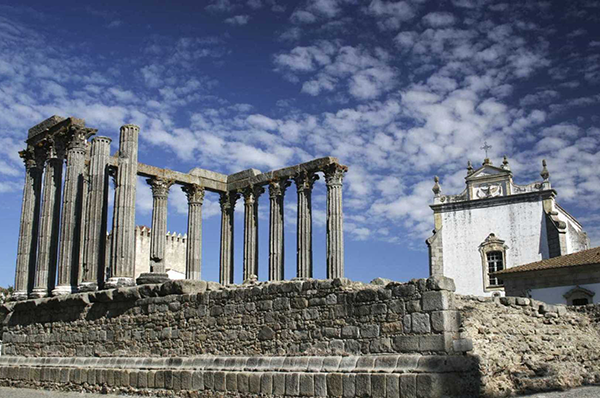
Portugal is one of the world’s oldest nation-states, with over 800 years of history and relatively stable territorial borders. Washed over by civilizations such as the Celts, Visigoths, Phoenicians, Romans, and the Arab and Berber cultures of North Africa, the Portuguese developed a cosmopolitan outlook that was simultaneously influenced by many others while it was exported abroad.
During the colonial era, the links between the various parts of the Lusophone world could hardly be said to have been free and open, but today, Portugal is a small, open economy that exhibits a unique blend of Old and New World charms.
It’s a place where award-winning works of contemporary architecture coexist with picture-book castles, and where its various attractions keep making “best-of” lists of all kinds.

Lisbon is still considered one of the cheapest cities in the European Union – ranking 2nd and 6th in the years 2010 and 2011, among the 35 cities polled by Cushman & Wakefield.
Practical examples of the cost of living in Lisbon:
1 croissant or other pastry + espresso in most Lisbon cafes= € 2.00
1 McMenu Big Mac, with fries and drink = € 5.40
Grilled ham and cheese + bowl of soup in most cafes = about € 5.00
1 gelato cone at Lisbon’s best ice cream shop= € 3.00
1 Daily Newspaper = € 1.10
1 Metro ride = € 1.75
1 ticket Lisbon – Porto = € 42.90 (fast train) / 35.90 (regular)
1 Liter of Gas = € 1.57 (1 Gallon = 3.785 Liters)
For a nice guide on how to shop around for the best bank rates, see here.
Money: To access cash in Euros, students are usually best served by simply using their ATM cards from the USA. Most US banks charge a fee for each foreign transaction though, so check with your bank about their policy for foreign ATM use and foreign purchase fees. Portuguese ATMs do not charge you a fee at the kiosk, only your home bank charges you.
The maximum withdrawal per ATM transaction is €200. Students will often need cash because many vendors do not take Visa nor MasterCard, only Portuguese Multibanco cards. For a nice guide on how to shop around for the best bank rates in the US, see here.
US students who are staying for an entire academic year may find it useful to open up a Portuguese checking account, which we can help you open.
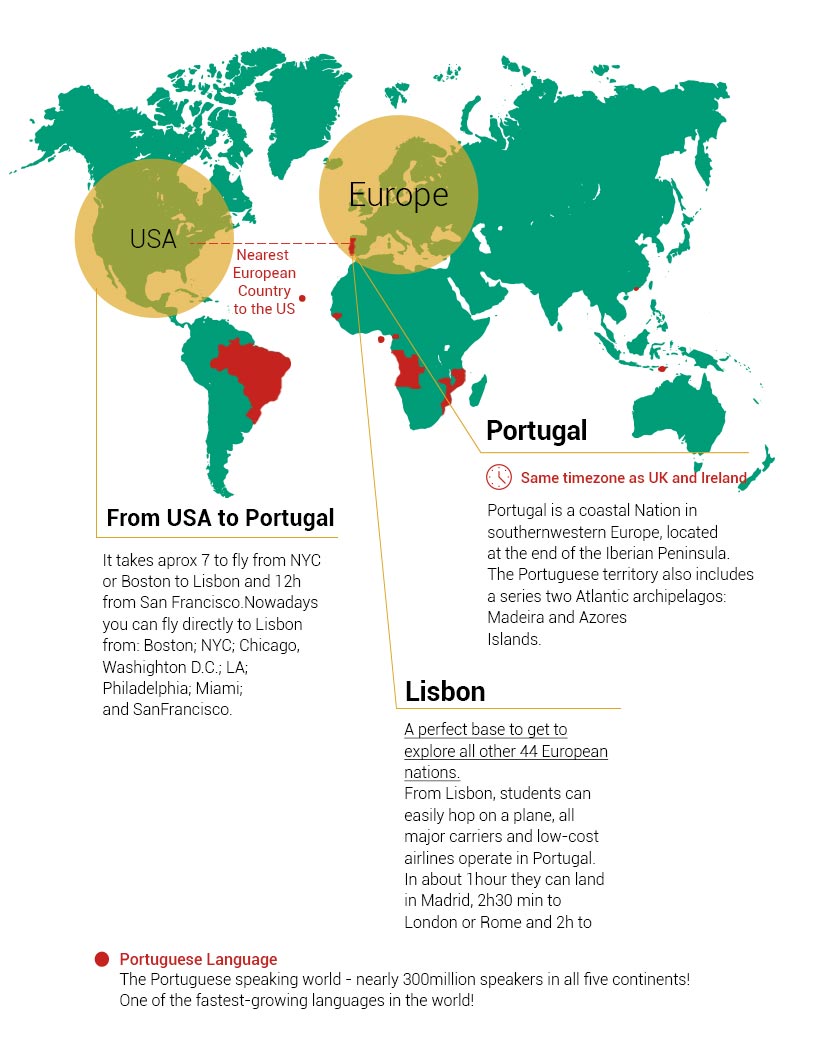
This propitious location, among other factors, allowed for an age of Portuguese “discoveries” during the 15th and 16th centuries that brought the language to the other continents. Whereas the Portuguese were the “first in and last out” of the European imperialist project, the positive legacies of that era are now visible in the cosmopolitanism of its cities, and the growing cultural and economic links between the various regions of the Lusophone world—which now represents the world’s 6th most spoken language.
Portugal is certainly recognized for its ancient spirit and rich history but nowadays is much more than that. Portugal, with Lisbon in its epicenter, is nowadays a vibrant and multicultural city, an authentic hub of the Portuguese speaking world (Portuguese is present in all 5 continents making it the 5th most spoken language in the world and growing), a confluence of cultures from Portuguese former colonies, enriched by a recent wave of incomers such as entrepreneurs, tech nomads, investors, multinational employees that chose Lisbon as their new home. This melting pot certainly has contributed to the amplification of various forms of cultural expression that are a result of this blending process itself. Gastronomy is a fine example, such as it is music, cinema, literature, etc. Fado (meaning soul) is the most popular music genre in Portugal. One can never miss a chance to learn about the history of this musical expression and feel it first hand by visiting some of the most traditional neighborhoods and Casas de Fado in the city: Bairro Alto, Alfama, and Mouraria.
For the first time in the history of the World Tourism Awards (Tourism’s “Oscars”), Portugal won the title of “World’s Leading Tourism Destination 2017”, a designation that was preceded by its award in October 2017 as “Best European Destination”. Ever since, and for three years in a row, Portugal has won “World’s Leading Tourism Destination.” Aside from these awards, Portugal also won Best Tourism Board (Turismo de Portugal) and Best Official Tourism Site (visit portugal.com).
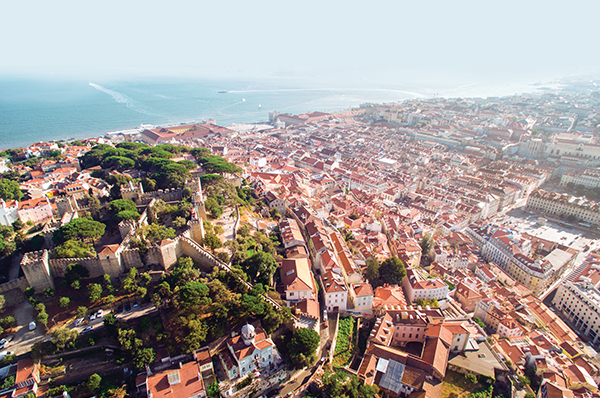
Awarded the title of European City of the Year in both 2010 and 2012, Lisbon is a capital city that offers an unmatched quality of life. Combining a rich culture, stunning architecture and great weather all year around, Lisbon is a city that has much to offer to international students.

Situated in the middle of the Atlantic Ocean bridging the European and the American continents, the Azores archipelago is an unmissable location to discover and explore. Each nine of its islands offer its own distinctive culture, gastronomy and landscapes.